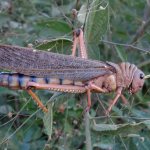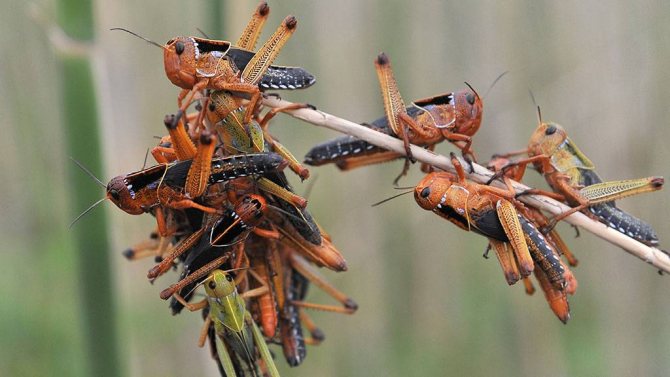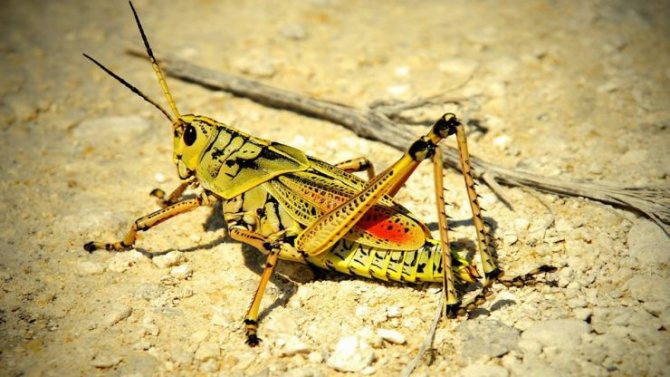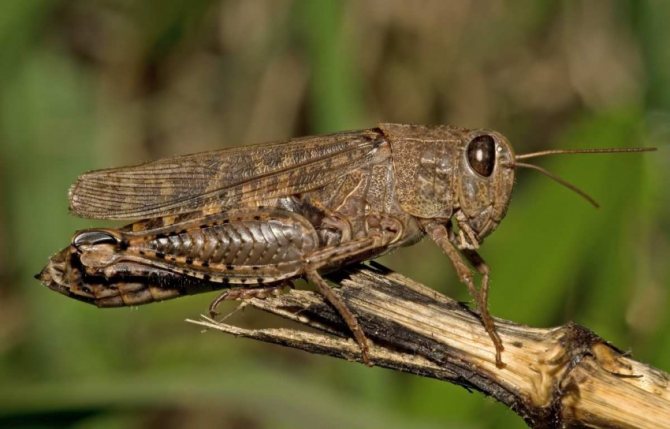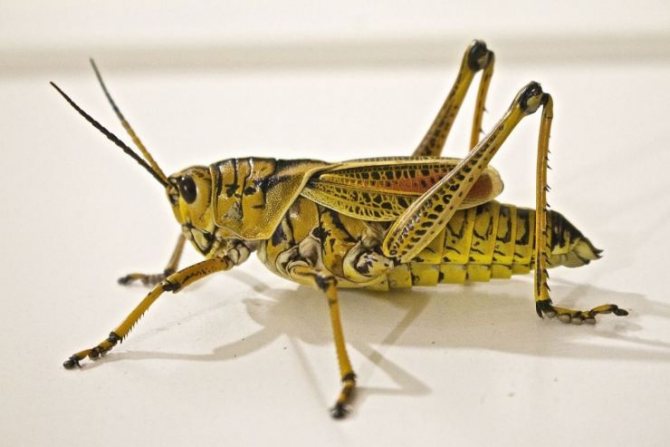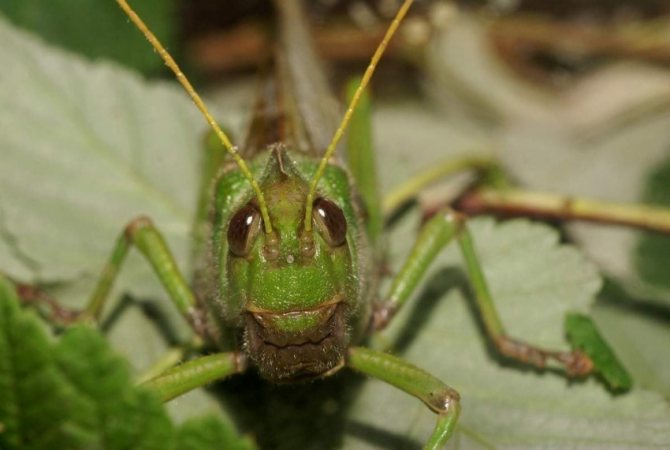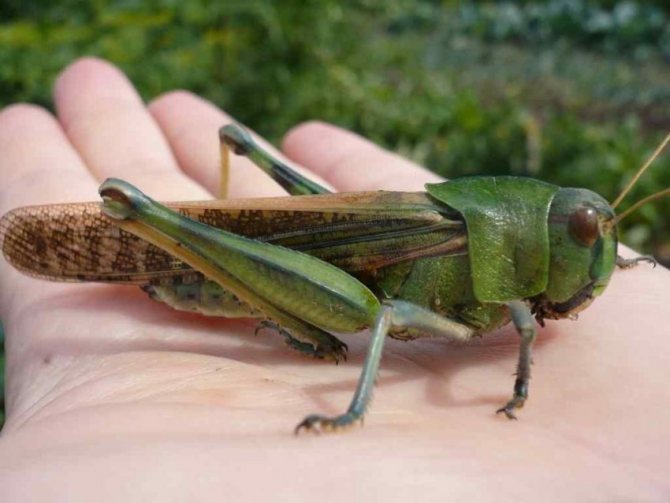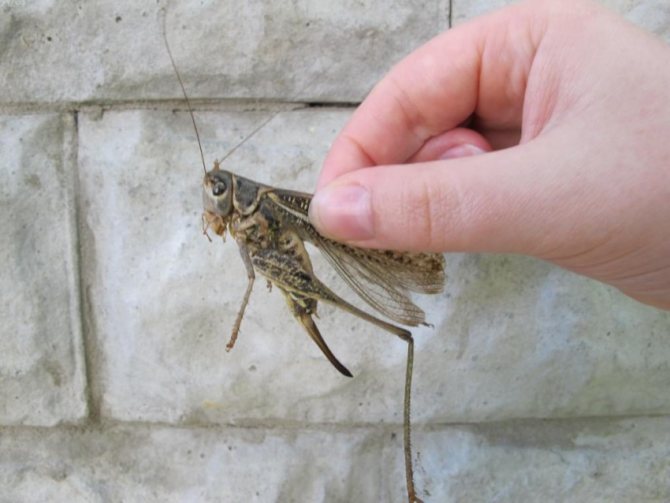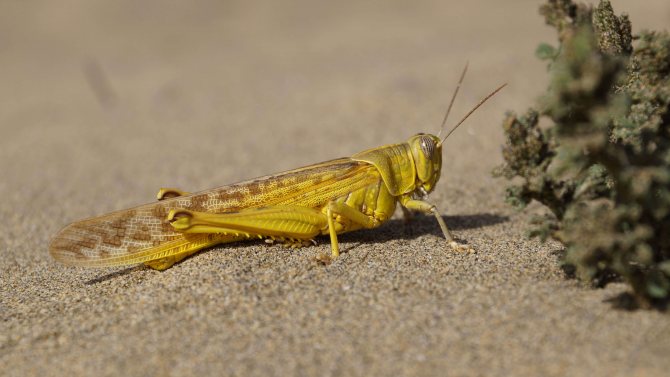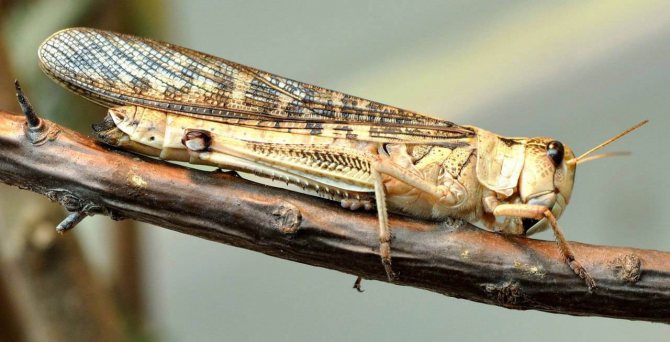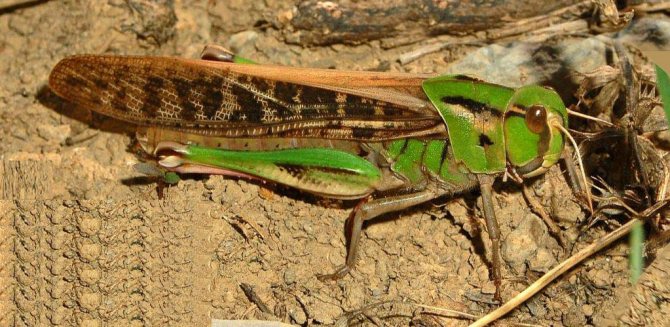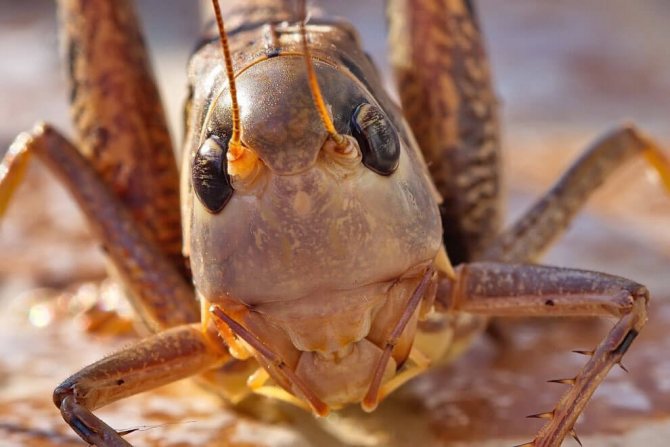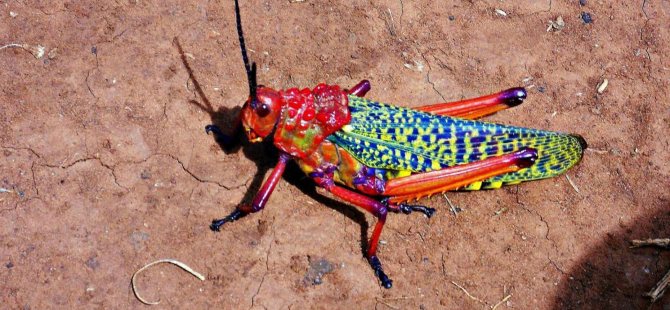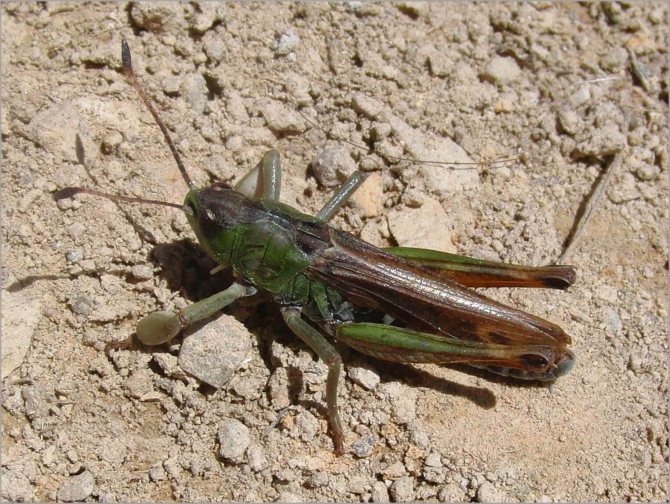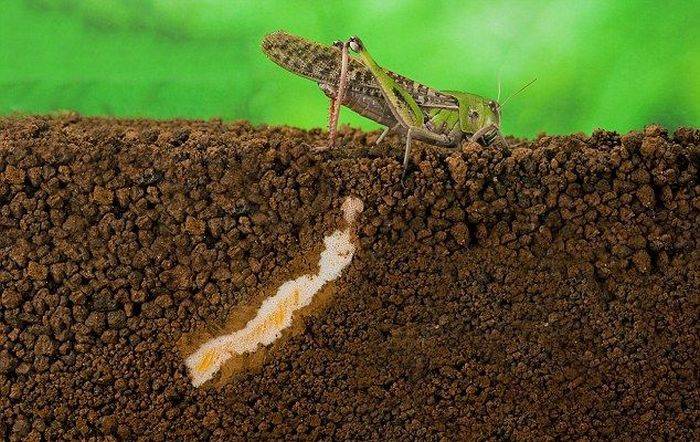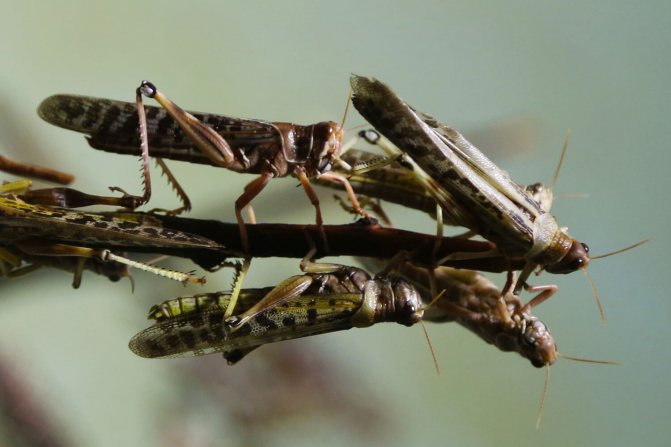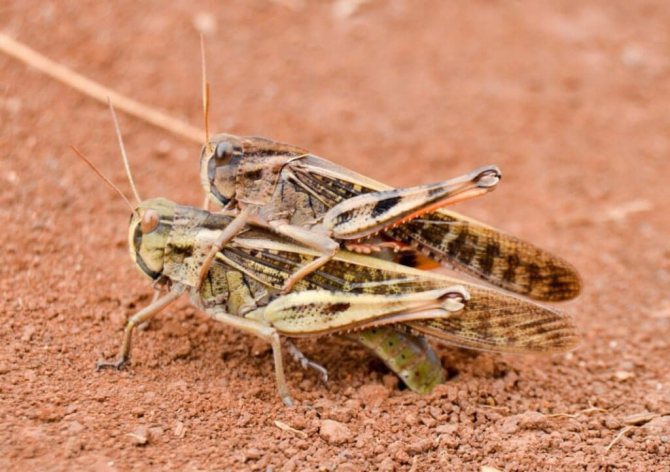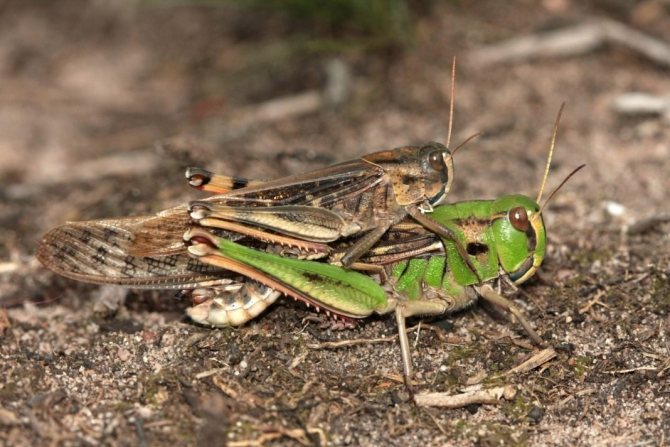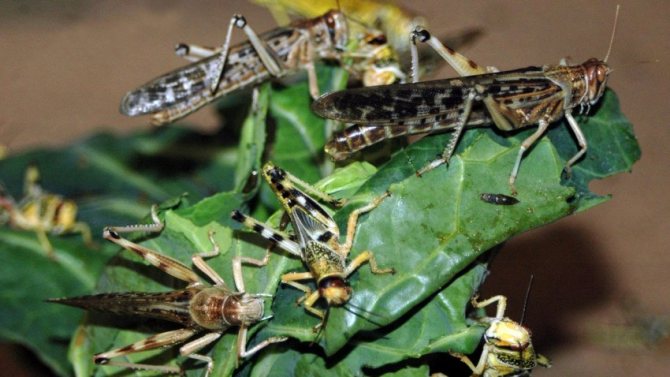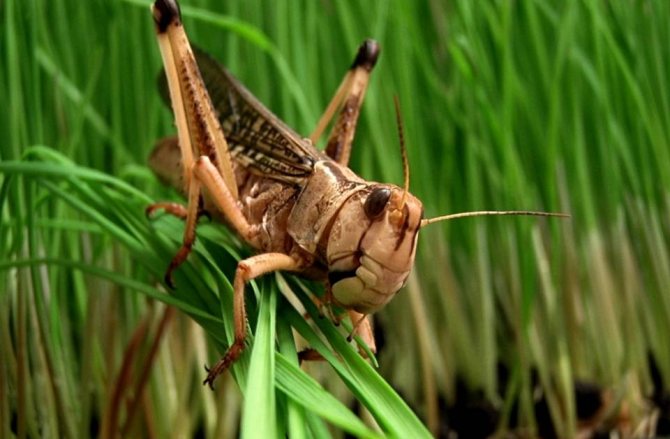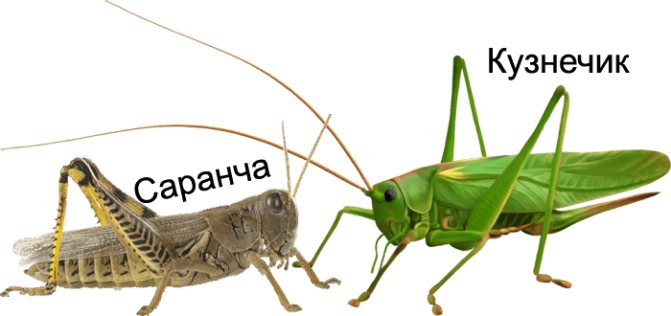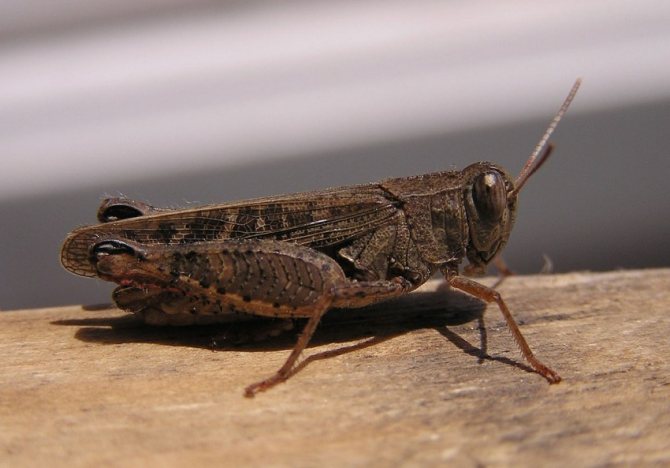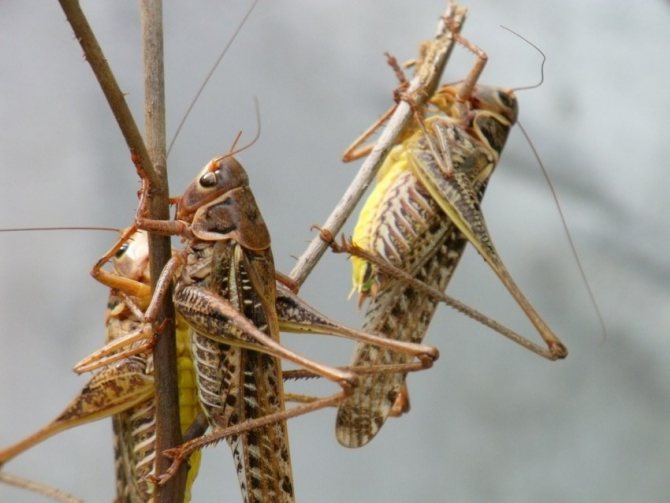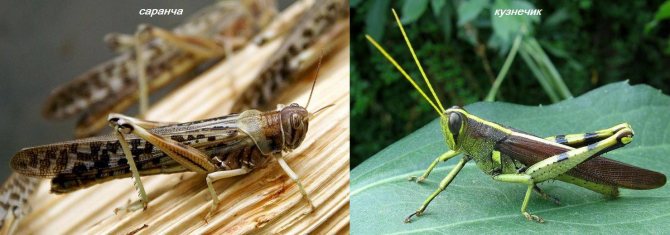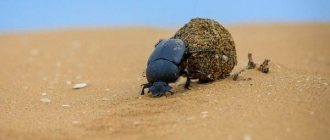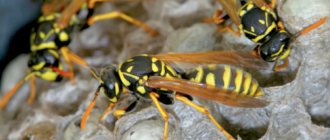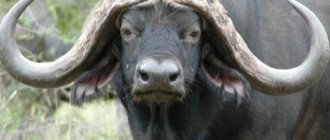Locusts (Acrididae) - a representative of the species "true locusts". It can gather in groups of up to several million individuals. This type of insect moves over great distances in the course of its life. Locusts are capable of being in two different states - solitary and gregarious. Each state has its own characteristics.
Locusts are common throughout planet Earth. The exceptions are territories with the lowest temperatures - the Far North and Antarctica. Locusts are found in a wide variety of places: in parks and forest belts, in fields and vegetable gardens. The fate of this amazing creature can follow two opposite scenarios.
In the first variant, the locust lives in complete solitude.
In the second, in a multi-million dollar group.

A solitary locust does not pose a danger to cultural plantings, but as soon as it meets its own kind, the herd instinct awakens in it. And the locust destroys all crops encountered in the path of the flock.
Insect description
The locust family (Latin Acrididae) includes more than 1,000 species of insects, of which 400 inhabit Asian-European countries, including Russia (regions of Central Asia, Kazakhstan, the Caucasus, south of Western Siberia and the European part). The most harmful and widespread species is the Asian locust, or migratory (Locusta migratoria).
According to the external description, it is similar to ordinary grasshoppers, only of a larger size. As you can see in the photo, the Asian migratory locust is a large insect reaching 6 cm in length, has a green-brown or olive color of the body and well-developed wings that help to overcome huge distances (up to several thousand kilometers) at a speed of 10-15 km / h ... The body structure is typical of Orthoptera and consists of 3 segments: head, chest and abdomen. The locust moves along the ground with the help of jumping legs, making high jumps.
The head has small antennae, as well as powerful jaws and a curved sharp keel located on the pronotum. The wings are divided: the front ones are denser, brown in color, the rear ones are transparent yellow-green, more delicate in structure.
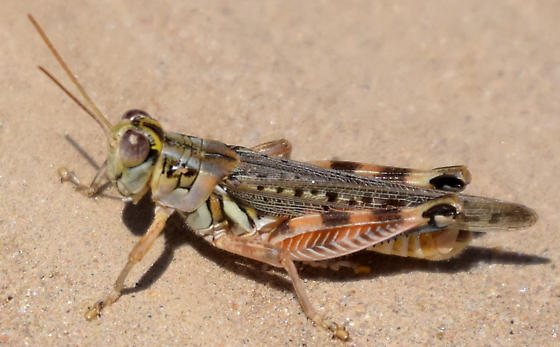

Lifestyle and nutrition
In the development of the migratory locust, there are 2 main phases: solitary and gregarious. It is in the latter that this insect poses a danger, devastating crops and destroying all plants that come across in its path. Due to its omnivorous nature, it is able to actively eat, each eating up to 0.5 kg of plant mass per day! The locust eats leaves, flowers, branches, stems and fruits, preferring the morning and evening hours, and rests in the heat.
During the summer season, 1 female, together with her offspring, eats as much as 2 sheep consume. Swarms of locusts sometimes number up to 1 million insects, so the raid of such a horde on fields leads to the death of the crop. The locust's favorite delicacy is reed, as well as melons and gourds and garden plants.


WHAT IS EATED ON
Locusts usually live on the leaves and flowers of green plants. With strong upper mandibles, they gnaw the leaves, and with smaller and weaker lower mandibles, they grind.
Since locust mandibles move from side to side, insects usually sit in the center of the leaf, on its longitudinal axis, and gnaw the leaf from edge to edge.Only a few species of true locusts feed exclusively on grass. Most locust species feed on the leaves of perennial plants, shrubs and trees. Some locust species can even feed on poisonous plants that other insects and animals do not eat.
Concentrating in their body, the poison provides insects with protection from enemies, since they themselves become poisonous. These locusts have a bright coloration that warns of their inedibility.
Reproduction: laying eggs
The answer to the question of how long the migratory locust lives depends on many external factors that affect the insect's life cycle: nutrition, climate, etc. It is believed that it can live from 8 months. up to 2 years.
In the solitary phase, the locust exists as a large green insect, which is also called the "green filly". She is harmless and inactive. This is the period when females mate with males and lay eggs after 30-40 days, which occurs in the second half of summer.
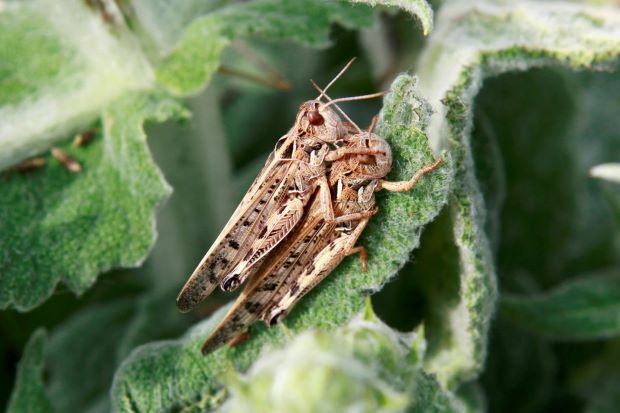

When laying eggs, the female envelops them with a foamy liquid secreted from the glands, which quickly hardens in air. At the same time, it forms several capsules (egg-pods) with a lid, each containing 50-100 eggs. In total, the total masonry can be 300-350 pieces. During the summer season, each female can form up to 3 generations of offspring.
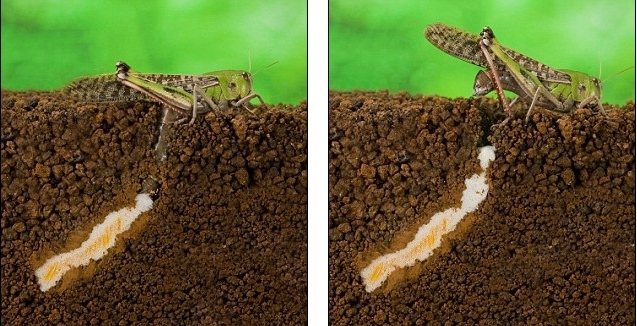

A place for a pod with eggs is chosen in a loose, preferably sandy and rather moist soil. Popular places for masonry are river floodplains and the banks of reservoirs, surrounded by sedge and reeds. In early autumn, with the arrival of cold weather, all adults (females and males) die. In the winter months, the masonry does not freeze even in severe frost.
FEATURES OF THE DEVICE
All locust species emit a characteristic "chirping". This peculiar "singing" of insects in many people recalls the image of a blooming meadow on a hot summer day. The locust sound apparatus is located on the hips of the hind legs and elytra. Hillocks stretch along the inner surface of the thigh, and one of the elytral veins is thicker than the others. Locusts make sounds, quickly moving their hips, while the tubercles touch the vein. Since the bumps are uneven, the result is an abrupt chirping. In most locust species, both males and females chirp.
Locust development: from larva to imago
The development of the insect under consideration is characterized by 3 stages (egg - larva - imago), that is, this is an incomplete transformation. Migratory locust larvae appear only at the beginning of the next spring, bypassing the pupal stage. This happens after the soil has warmed up to the desired temperature, usually in May.
The larvae are similar to adult insects, only smaller. As they develop, they shed several times (4-5), gradually increasing in size, which occurs within 35-40 days. Plants rich in protein serve as food for the younger generation: wheatgrass, reeds, wild cereals.
In the solitary phase, the insect can exist, feeding quietly all summer and then laying eggs for laying a new generation. Completely harmless green filly have a slight bulge ("hump") on the back and lead an inactive lifestyle.
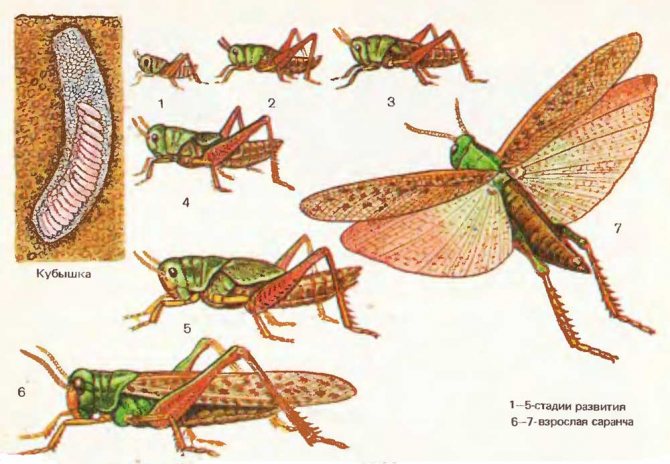

Lodging
It is easy for locusts to organize a dwelling. You need a container that is large enough, has some ventilation and can be properly closed to prevent escapes. Locusts can chew through fabric, so mesh cages and containers with gauze lids are not suitable. A faunarium, glass terrarium, or a plastic container with a metal mesh for ventilation will work. If you keep locusts as pets, a glass terrarium with a mesh lid will work well.If you are feeding reptiles or praying mantises, buy a more practical plastic container as it is lightweight and cheap. Make sure the container is large enough for all locusts. The approximate size for a dozen adults is 50 x 50 x 30 cm. Bigger is always better.
Fill the bottom of the container with dry sand, dry oatmeal, or dry coconut substrate. Place dry twigs or sticks inside to provide extra seating surface. Food - grass and / or leaves - will also serve as a decoration and a "nest". Make sure the container is lit by either a light bulb (see the next section on temperature) or natural light. Direct sunlight falling on the container can heat it up too much, do not allow it to overheat.
Herd form, flock formation
The signal for the formation of a flock of the Asian migratory locust is the lack of protein food, which happens on average every 10-12 years (the interval between epiphytoties). The gregarious phase of the locust's existence is characterized by the reproduction of insects in extreme quantities, when the larvae, even after growing wings, grow sharply to 6-6.5 cm in length. They straighten their backs, acquiring a gray-brown spotted color, and begin to gather in bands - columns, massively destroying all the plants around.
After the 4-5th molt, all insects in the flock acquire wings and begin their "nightmare" flight in search of food. A swarm of locusts can fly without a break for 12 hours, covering distances of hundreds of kilometers, and with a fair wind - up to 1,000 km! When planting, insects even break tree branches with their weight.
Locust plague
During a massive flight, millions of insects produce a frightening thunderous sound that arises from the total crackling of their wings. Insects feed in a flock practically without interruption, trying to normalize the protein balance in the body. They eat completely all grain crops (wheat, barley, rye, corn and oats), gnaw all bushes and trees, pastures and grass in the fields. On their way, they eat overgrowths of melons and legumes, leaves on root crops, etc.
They are capable of moving 50-300 km in the surrounding area per day. And along the way, many insects in the flock turn into predators, devouring their own kind, and not just plants.


Interesting facts about the common locust species
Due to the large amount of protein in the insect, in a number of states this pest is served on the table as a snack.
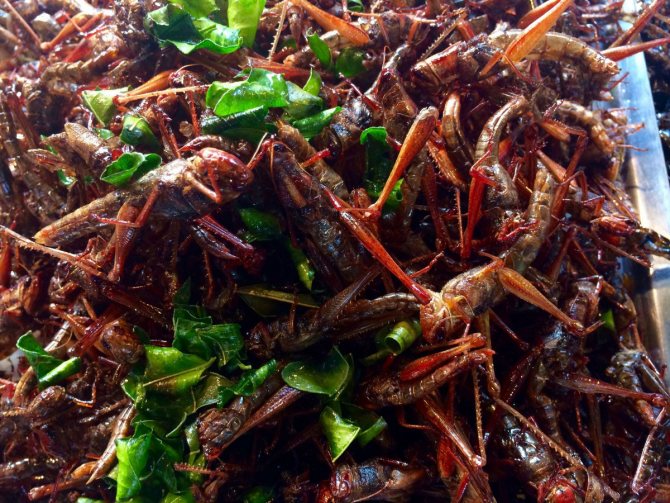

Some insect species have a striking, flashy color. This is no accident. As a rule, this is how locusts warn those wishing to attack them about their poisonousness. This is due to the eating of poisonous plants by the locust, the poison from which accumulates in the insect's body over time.
Communication of insects in a flock
Large communities of migratory locust could not survive long if they did not communicate with each other. In a flock, for communication, they use sound and visual signals, touch, and use chemical stimuli in the form of odors. In order to make sounds, insects have formed special organs. Thus, locusts emit a chirping, or stridulation sound, which is caused by rubbing with their paws or wings of other parts of the body with a certain frequency and rhythm, for which they have teeth (80-90 pieces) located along the edges.
Other sounds insects produce with the help of membranes located on the abdomen - these are clicks and pops, they can also knock their heads on stems, leaves or the ground. Scientists suggest that echolocation is also used to coordinate the movement of large flocks.Migratory locusts, huddled in huge bands, sometimes numbering up to a million individuals, migrate in a certain area, flying from one field to another and destroying everything around.
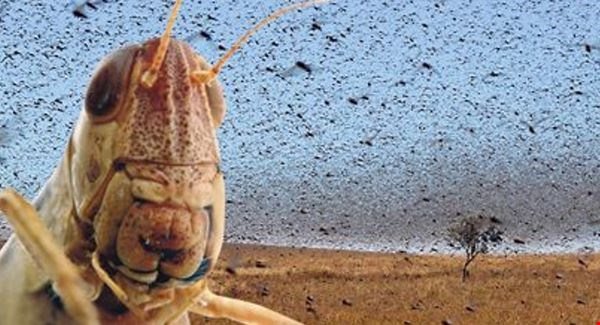

Interesting Facts
Among the features of the structure and life of the locust, there are many interesting facts:
- Due to the fact that the insect has well-developed hind legs, it can move in one jump a distance exceeding the size of the body twenty times.
- When eating locusts, they eat everything that is colored green. As soon as food with a greenish tinge runs out in a closed room, the locust begins to eat its congeners, if they are greenish in color.
- Insects can fly huge spaces without landing - up to four hundred kilometers. The longest flight of a locust swarm is from the African continent to the islands of the Caribbean Sea. A herd of locusts on foot overcomes an area of twenty kilometers during daylight hours.
- 7000 tons of citrus in 5 days were swallowed by the locust community that attacked the orange tree plantations in Morocco. Amazing gluttony - one ton per minute.
- Locust – insect, which inhabits all continents of the globe, the only exception is Antarctica. This is due to the harsh climatic conditions and the complete lack of food. But an interesting fact, they are not in North America either. Last known locust infestation on the continent dates back to 1875.
- The most unusual way to control locusts was recorded in the 15th century in France. The judge, who was considering the case of damage to the vineyards by insects, made a decision on the allocation of a plot of land for them, which was strictly forbidden for the pests to leave.
- Locusts are included in the menu of many peoples of the world. These insects are eaten in thirty-six states located on the African continent, twenty-nine Asian countries and twenty-three states on the South American continent. Studies have shown that locusts are nutritious food that can replace meat, they are low in fat and high in vitamins.
Locust control
The natural decrease in the number of locusts in a flock occurs due to outbreaks of the disease, which are possible with a high density of insects in bands, as well as when they become infected in egg-pods. It is also destroyed by entomophages (predatory insects, which include ground beetles, ants, spiders, etc.) in the stage of larvae and adults. Locusts also have their own natural enemies: predatory insects, birds, etc.
Locust control has been going on for many years and includes several methods:
- agrotechnical - autumn plowing of the land, which allows you to get rid of winter clutches of insect eggs;
- economic, which include sowing strips of industrial crops to protect grain crops, weed control, development of virgin lands;
- chemical - treatment of the territory by spraying insecticides from aircraft;
- poisoned baits laid out in the fields - for the destruction of single individuals.
Preventing dramatic increases in migratory locust populations during the breeding season helps to reduce the damage that swarms can cause to crops and plants.

